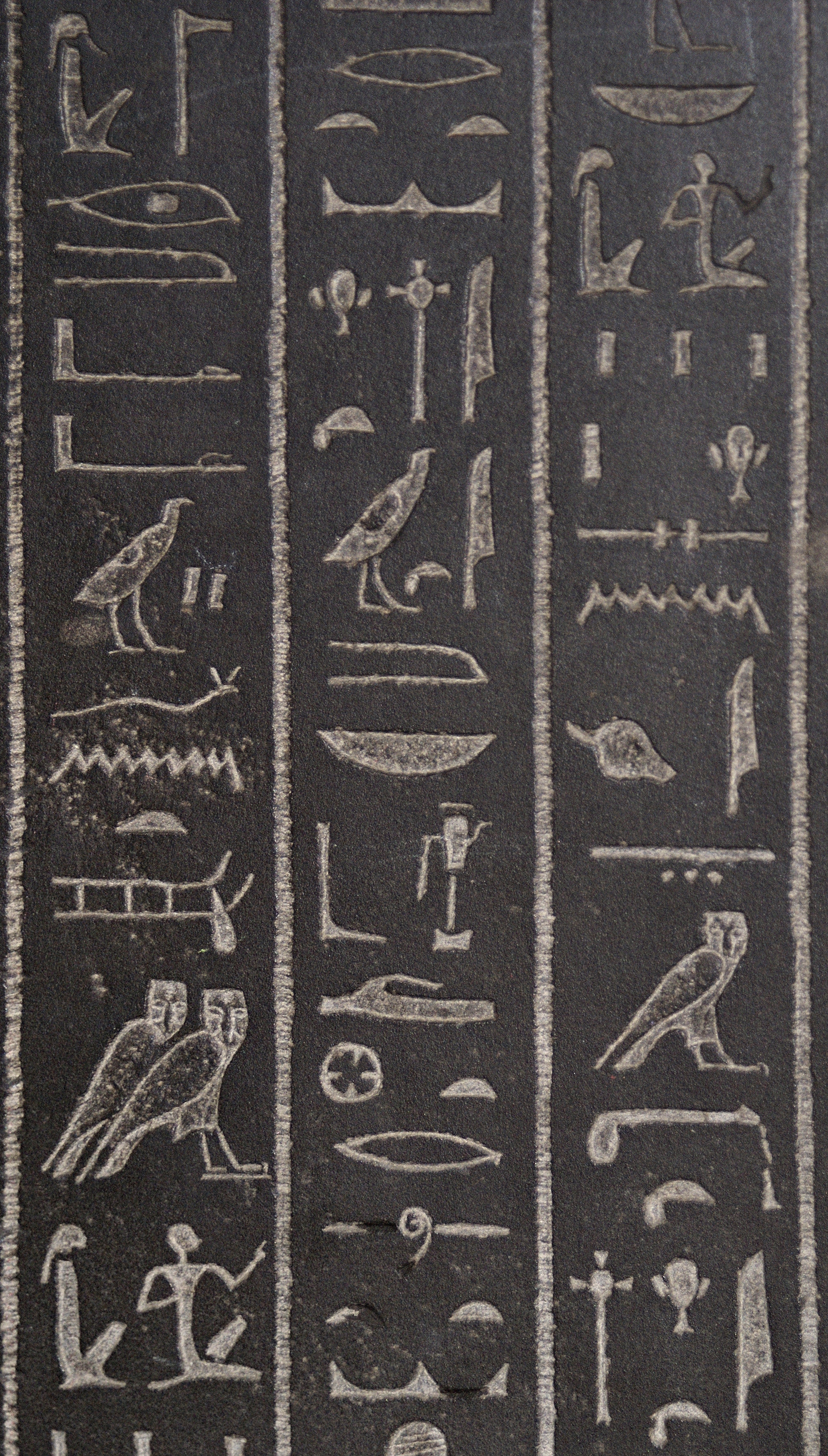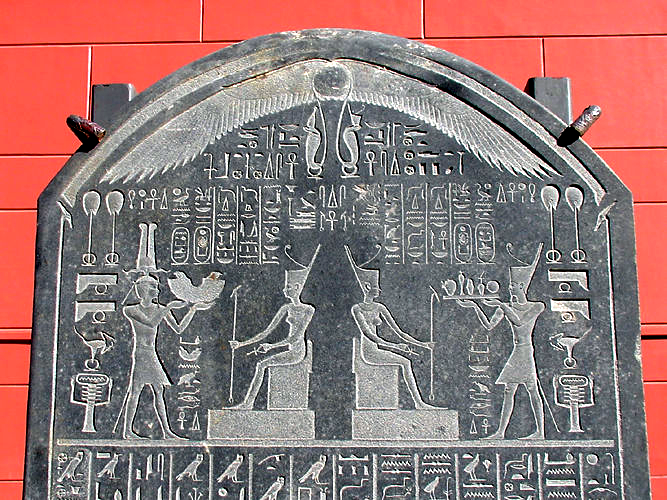|
Night (hieroglyph)
The ancient Egyptian Night hieroglyph, Gardiner sign listed nos. N3 is a portrayal of the ''sky with the 'was' scepter hanging from it''; it is in the Gardiner subset for "sky, earth, and water". In the Egyptian language, the ''night hieroglyph'' is used as a determinative for words relating to 'obscurity'. In the language it is used for ''grh''-(grḥ), and ''w(kh)''-(uḫ) for night, and ''kkw''-(kku) for dark, and a determinative for other related words.Betrò, 1995. ''Hieroglyphics: The Writings of Ancient Egypt'', Sky, p. 150. See also *Sky (hieroglyph) * Gardiner's Sign List#N. Sky, Earth, and Water *List of Egyptian hieroglyphs The total number of distinct Egyptian hieroglyphs increased over time from several hundred in the Middle Kingdom to several thousand during the Ptolemaic Kingdom. In 1928/1929 Alan Gardiner published an overview of hieroglyphs, Gardiner's sign ... References *Betrò, 1995. '' Hieroglyphics: The Writings of Ancient Egypt,'' Betr ... [...More Info...] [...Related Items...] OR: [Wikipedia] [Google] [Baidu] |
Gardiner's Sign List
Gardiner's Sign List is a list of common Egyptian hieroglyphs compiled by Sir Alan Gardiner. It is considered a standard reference in the study of ancient Egyptian hieroglyphs. Gardiner lists only the common forms of Egyptian hieroglyphs, but he includes extensive subcategories, and also both vertical and horizontal forms for many hieroglyphs. He includes size-variation forms to aid with the reading of hieroglyphs in running blocks of text. In contrast, for example, the Budge Reference has about 1,000 hieroglyphs listed in 50 pages, but with no size variations. Gardiner does not cross-index signs; once put on the list, other significant uses may be overlooked. One example of this is G16, nbtỉ, the ideogram for the Two Ladies, goddesses Wadjet as the cobra and Nekhbet as the white vulture. These are the protective and patron goddesses of the separate Egyptian kingdoms that joined into ancient Egypt, who were both then displayed on the uraeus of Wadjet when the unification ... [...More Info...] [...Related Items...] OR: [Wikipedia] [Google] [Baidu] |
Was (sceptre)
The ''was'' (Egyptian ''wikt:wꜣs, wꜣs'' "power, dominion") sceptre is a symbol that appeared often in relics, art, and hieroglyphs associated with the ancient Egyptian religion. It appears as a stylized animal head at the top of a long, straight staff with a forked end. ''Was'' sceptres were used as symbols of power or dominion, and were associated with ancient Egyptian deities such as Set (deity), Set or Anubis as well as with the pharaoh. ''Was'' sceptres also represent the Set animal or Khnum. In later use, it was a symbol of control over the force of chaos that Set represented. In a funerary context the ''was'' sceptre was responsible for the well-being of the deceased, and was thus sometimes included in the tomb-equipment or in the decoration of the tomb or coffin. The sceptre is also considered an amulet. The Egyptians perceived the sky as being supported on four pillars, which could have the shape of the ''was''. This sceptre was also the symbol of the fourth Upper Eg ... [...More Info...] [...Related Items...] OR: [Wikipedia] [Google] [Baidu] |
Egyptian Language
The Egyptian language or Ancient Egyptian ( ) is a dead language, dead Afroasiatic languages, Afro-Asiatic language that was spoken in ancient Egypt. It is known today from a large Text corpus, corpus of surviving texts which were made accessible to the modern world following the decipherment of ancient Egyptian scripts, decipherment of the ancient Egyptian scripts in the early 19th century. Egyptian is one of the List of languages by first written accounts, earliest written languages, first being recorded in the Egyptian hieroglyphs, hieroglyphic script in the late 4th millennium BC. It is also the longest-attested human language, with a written record spanning over 4000 years. Its classical language, classical form is known as Middle Egyptian, the vernacular of the Middle Kingdom of Egypt which remained the literary language of Egypt until the Egypt (Roman province), Roman period. By the time of classical antiquity the spoken language had evolved into Demotic (Egyptian), Dem ... [...More Info...] [...Related Items...] OR: [Wikipedia] [Google] [Baidu] |
Determinative
A determinative, also known as a taxogram or semagram, is an ideogram used to mark semantic categories of words in logographic scripts which helps to disambiguate interpretation. They have no direct counterpart in spoken language, though they may derive historically from glyphs for real words, and functionally they resemble classifiers in East Asian and sign languages. For example, Egyptian hieroglyphic determinatives include symbols for divinities, people, parts of the body, animals, plants, and books/abstract ideas, which helped in reading, but none of which were pronounced. Cuneiform In cuneiform texts of Sumerian, Akkadian and Hittite languages, many nouns are preceded or followed by a Sumerian word acting as a determinative; this specifies that the associated word belongs to a particular semantic group.Edzard, 2003 These determinatives were not pronounced. In transliterations of Sumerian, the determinatives are written in superscript in lower case. Whether a given sign ... [...More Info...] [...Related Items...] OR: [Wikipedia] [Google] [Baidu] |
Pick (hieroglyph)
The ancient Egyptian Pick hieroglyph, Gardiner sign listed nos. U17, U18 is a portrayal of a 'pick upon the side view of a block'; it is in the Gardiner subset for ''agriculture, crafts, and professions''. In the Egyptian language, the ''pick hieroglyph'' is used as an ideogram or determinative for ''grg'', the verb "to pick through", or for other related words. Verb: to settle, found, establish; (also dismantle) Though the ''pick hieroglyph'' shows: 'use of a pick, upon a surface', the verb "to choose" is not implied. The Egyptian language verb for 'to pick or select' is used by "to choose", the commonly used ''stp'' hieroglyph, an adze, or specifically the ' adze-on-block (hieroglyph)', Gardiner no. U21, U21, also in the Gardiner subset of ''agriculture, crafts, and professions''. The pick hieroglyph in Budge's two volume dictionary has twelve entries, the final three dealing with "lies" and using the determinative of the sparrow (hieroglyph), for 'bad', 'evil', Gardiner ... [...More Info...] [...Related Items...] OR: [Wikipedia] [Google] [Baidu] |
Relief
Relief is a sculptural method in which the sculpted pieces are bonded to a solid background of the same material. The term ''relief'' is from the Latin verb ''relevo'', to raise. To create a sculpture in relief is to give the impression that the sculpted material has been raised above the background plane. When a relief is carved into a flat surface of stone (relief sculpture) or wood (relief carving), the field is actually lowered, leaving the unsculpted areas seeming higher. The approach requires a lot of chiselling away of the background, which takes a long time. On the other hand, a relief saves forming the rear of a subject, and is less fragile and more securely fixed than a sculpture in the round, especially one of a standing figure where the ankles are a potential weak point, particularly in stone. In other materials such as metal, clay, plaster stucco, ceramics or papier-mâché the form can be simply added to or raised up from the background. Monumental bronze reliefs a ... [...More Info...] [...Related Items...] OR: [Wikipedia] [Google] [Baidu] |
Quadrat (hieroglyph Block)
A quadrat block (or ''quadrate block'') is a virtual rectangle or square in Egyptian hieroglyphic text. The glyphs (hieroglyphs) can be variable in number within the ''virtual block'', though they are often proportioned according to variable standardized rules of scribal methods. The definition for the block in ''Illustrated Hieroglyphics Handbook'' by Schumann-Antelme and Rossini, is: "A 'quadrate' is a virtual square, which although not drawn, guides the hand of the scribe. Hieroglyphs must be aesthetically positioned within the quadrate and their size must be proportioned accordingly. They form groups that are pleasing to the eye and based on the laws of balance." Rosetta Stone closeup An example of five lines of text from the Rosetta Stone, (lines 9, 10, 11, 12, 13), shows a width of about six to seven virtual blocks. Line 12, (fourth line) is illustrative of the variable size, in this case the widths, of the 'virtual quadrate blocks'. :The time of the festivals are stated a ... [...More Info...] [...Related Items...] OR: [Wikipedia] [Google] [Baidu] |
Lunette (stele)
The lunette spatial region in the upper portion of stelas, became common for stelas as a prelude to a stele's topic. Its major use was from ancient Egypt in all the various categories of stelas: funerary, Victory stelas, autobiographical, temple, votive, etc. The lunettes are most common from ancient Egyptian stelas, as not only is the topic of the stele presented, but honorific gods, presenters, individuals, etc. are previewed, and often with Egyptian hieroglyphic statements. The main body of the stele is then presented below, often separated with a horizontal line (register), but not always. In Egyptian stelas, many have horizontal lines of hieroglyphs; often the lunette will contain shorter vertical statements in hieroglyphs, sometimes just names of the individuals portrayed, hieroglyphs in front, or behind the individual. 19th Dynasty Egypt, post Amarna From the post-Amarna period onwards, many personal stelas made exhortations to the ancient Egyptian deities; stelas to sp ... [...More Info...] [...Related Items...] OR: [Wikipedia] [Google] [Baidu] |
Bas Relief
Relief is a sculptural method in which the sculpted pieces are bonded to a solid background of the same material. The term ''relief'' is from the Latin verb ''relevo'', to raise. To create a sculpture in relief is to give the impression that the sculpted material has been raised above the background plane. When a relief is carved into a flat surface of stone (relief sculpture) or wood (relief carving), the field is actually lowered, leaving the unsculpted areas seeming higher. The approach requires a lot of chiselling away of the background, which takes a long time. On the other hand, a relief saves forming the rear of a subject, and is less fragile and more securely fixed than a sculpture in the round, especially one of a standing figure where the ankles are a potential weak point, particularly in stone. In other materials such as metal, clay, plaster stucco, ceramics or papier-mâché the form can be simply added to or raised up from the background. Monumental bronze reliefs a ... [...More Info...] [...Related Items...] OR: [Wikipedia] [Google] [Baidu] |
Sky (hieroglyph)
The ancient Egyptian Sky hieroglyph, (also translated as ''heaven'' in some texts, or iconography), is Gardiner sign listed no. N1, within the Gardiner signs for ''sky, earth, and water.'' The ''Sky'' hieroglyph is used like an Egyptian language biliteral-(but is not listed there) and an ideogram in ''pt'', "sky"; it is a determinative in other synonyms of ''sky''. For the language value ''hrt'', it has the phonetic value ''hry''. The Sky hieroglyph is often written with the complement of its component values of " p", and "t", Q3, X1 in a hieroglyph composition block, N1:Q3*X1 meaning ''"pt"'', or commonly 'pet'. Pt, with Gods and the Pharaoh The Sky hieroglyph can be found in iconography with the gods, especially Ra as referencing the ''Lord of P(e)t'', (''Lord of Heaven''), and the God's ownership of ''Pet''. The Pharaoh is often equally named as the ''Lord of Pet.'' Some ancient Egyptian names using the ''sky'' hieroglyph are Petosiris and the god Petbe. Ligatured ... [...More Info...] [...Related Items...] OR: [Wikipedia] [Google] [Baidu] |


